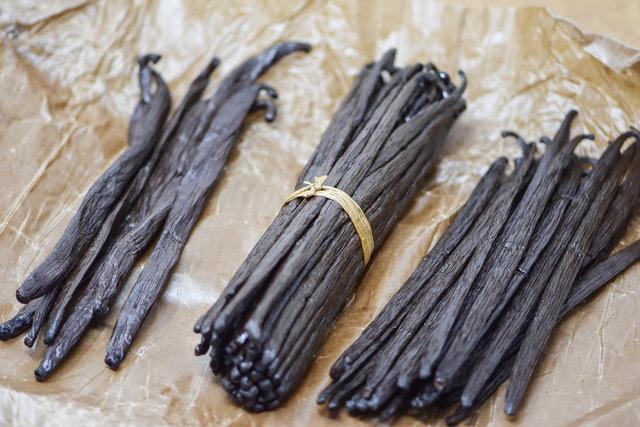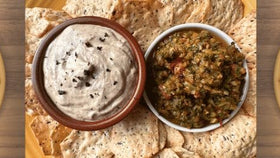Understanding the Difference Between the Various Types of Vanilla Beans
Classifying different types of vanilla beans can mean different things to different people. There are, in fact, a myriad of ways to categorize vanilla beans. We can break them down into species, and place of origin, and grades. Let’s take a look at the most common types of vanilla beans and examine what makes them unique from one another.
Species of Vanilla Beans
While in the grand scheme of things there are many types of vanilla beans, there are only two main species of vanilla orchid cultivated for commercial vanilla production.
Vanilla Planifolia
Vanilla Planifolia is the most common species of the vanilla orchid. It is the first species of vanilla orchid— the plant that all vanilla roots can be traced back to. The pods host vanilla caviar emitting a rich, familiar vanilla flavor and aroma. It is the more potent vanilla variety and easily infuses a deep, earthy, vanillin flavor into any dish.
Vanilla Tahitensis
Vanilla Tahitensis is a very close cousin of Planifolia. It is named after the island upon which it’s commercial cultivation began, though its origin is debated among botanists and vanilla enthusiasts. Some claim it was intentional hybridization, others believe it was a natural evolution, and there are scientific research studies that suggest it was a bit of both—a natural hybridization between Vanilla Planifolia and Vanilla Odorata, which occurred in Maya cacao forests. Regardless of how Vanilla Tahitensis came to be, pastry chefs all over the world would be at a loss without it. It is prized for its subtle sweetness and unmatched floral properties. Vanilla Tahitensis is also more commonly found in fragrances, due to the floral aroma.
Types of Vanilla Beans, Based on Origin
Pretty simple, two types of vanilla bean species—one strong and earthy, the other subtle, floral, and sweet. But it gets more complicated because the vanilla orchid has been brought to tropical regions around the world and is now being cultivated in various growing regions and using a multitude of growing, harvesting, and curing methods—all of which contribute to varying flavor properties. Let’s take a look.
Mexican Vanilla Beans
All vanilla beans can actually be traced back to the Mexican Vanilla Planifolia. Today, Mexican vanilla beans are still primarily the Planifolia variety. They are the perfect addition or pairing for chocolate, full-bodied, smooth, and somewhat spicy.
Madagascar Vanilla Beans
Madagascar vanilla beans (beans in the center of the image) are commonly known as Bourbon vanilla beans because of the region in Madagascar in which they are derived. Since most Vanilla Planifolia comes from this region, Bourbon Vanilla is commonly used synonymously with the Planifolia species. They are quite often described as creamy and rich in vanillin flavor and are the most common type of vanilla bean found in commercial pure vanilla flavors. Bourbon vanilla beans are now cultivated in many regions beyond Madagascar.
Tahitian Vanilla Beans
Tahitian vanilla beans (bean on the far left in the image) are much shorter and plumper than their Bourbon cousin, and practically bursting with vanilla seeds. They are delicate and sweet with floral undertones and notes of red wine, peach, and cherry.
Ugandan Vanilla Beans
Though not nearly as common as the first three types of vanilla beans we mentioned, Ugandan vanilla beans (beans on the far right in the image) should not be overlooked when making a purchase decision for your culinary products. They land somewhere in between Mexican and Madagascar beans, with an intoxicating and buttery vanillin flavor and aroma reminiscent of chocolate and figs. Grown in the heart of Africa, Ugandan vanilla beans experience two harvests per year due to ample amounts of sunlight and rainy seasons. This make Ugandan vanilla appealing for those looking for the freshest possible vanilla beans.
Papua New Guinea Vanilla Beans
Much like the Ugandan variety, Papua New Guinea (PNG) vanilla beans are under-represented in the vanilla realm but are quickly gaining traction. Both Vanilla Planifolia and Vanilla Tahitensis are commonly grown in PNG, with the Bourbon variety contributing a well-balanced richness with buttery, caramel undertones, and the Tahitian variety emitting a dark yet subtle, oaky flavor with cherry undertones.
Indonesian Vanilla Beans
It's wild to me that Indonesian vanilla beans are not spoken of more often. After all, Indonesia is the second largest producer of vanilla in the world, second only to Madagascar. The distinctive curing process used in Indonesia contributes a deep smoky flavor that holds up remarkably well in heat applications.
Grades of Vanilla Beans
There are two primary grades of vanilla beans, Grade A and Grade B. Though some people go as far as to further segment them into subgrades (grade A-1, A-2, etc…).
Grade A Vanilla Beans
Grade A vanilla beans are also known as gourmet vanilla beans or premium vanilla beans. They have a much higher moisture content than the grade B variety, which means the vanilla flavor will quickly infuse into a dish. Gourmet beans have an obvious oily sheen on the pods and are visibly perfect in form. They are the perfect choice for culinary projects that do not require a long infusion process.
Grade B Vanilla Beans
Grade B vanilla beans are often referred to as extract vanilla beans because they are primarily used for making vanilla extract. Extract grade vanilla beans will often have bruising, scarring, or tearing on the pod, varying lengths, and maybe even some scorching from the sun. These imperfections do not harm the integrity of the vanillin flavor but do make them less desirable by chefs around the world. They have approximately 10-15% less moisture content than gourmet vanilla beans, which means a more concentrated flavor, making them the perfect choice for extracts, simple syrups, and dishes that can withstand a longer infusion process.
While these lists are not absolutely inclusive of every type of vanilla bean, they do give insight into the primary beans found commercially. Our hope is that this article helps you understand how to tell the difference between the various types of vanilla beans and make an informed decision prior to buying vanilla beans for your next project! Here's another article that can assist you in understanding what to look for when buying vanilla beans online.
We’d love to hear why you chose the type of vanilla bean you did and what you will be doing with us! Let us know in the comments section!







Slofoodgroup
Author